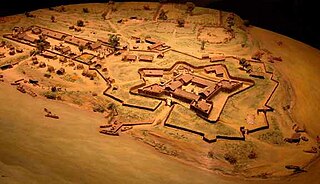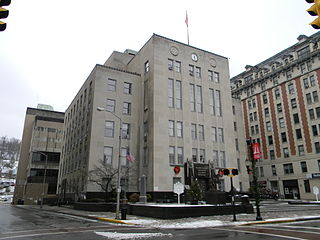
Daniel Boone was an American pioneer and frontiersman whose exploits made him one of the first folk heroes of the United States. He became famous for his exploration and settlement of Kentucky, which was then beyond the western borders of the Thirteen Colonies. In 1775, Boone founded the Wilderness Road through the Cumberland Gap and into Kentucky, in the face of resistance from Native Americans. He founded Boonesborough, one of the first English-speaking settlements west of the Appalachian Mountains. By the end of the 18th century, more than 200,000 people had entered Kentucky by following the route marked by Boone.

Fort Duquesne was a fort established by the French in 1754, at the confluence of the Allegheny and Monongahela rivers. It was later taken over by the British, and later the Americans, and developed as Pittsburgh in the U.S. state of Pennsylvania. Fort Duquesne was destroyed by the French before its British conquest during the Seven Years' War, known as the French and Indian War on the North American front. The British replaced it, building Fort Pitt between 1759 and 1761. The site of both forts is now occupied by Point State Park, where the outlines of the two forts have been laid in granite slabs.

Harrison County is a county in the U.S. state of West Virginia. As of the 2020 census, the population was 65,921, making it West Virginia's 7th most populous county. Its county seat is Clarksburg. Harrison County is part of the Clarksburg, WV Micropolitan Statistical Area.

Reuben Gold Thwaites was an American librarian and historical writer.
"Long knives" was a term used by the Iroquois, and later by the Mingo and other indigenous peoples of the Ohio Country to designate white settlers from Virginia, in contradistinction to those of New York and Pennsylvania.
George Hay Lee was a Virginia lawyer and politician who served on the Virginia Court of Appeals from 1852 until Virginia declared secession in 1861.

The Draper's Meadow Massacre was an attack in July 1755, when the Draper's Meadow settlement in southwest Virginia, at the site of present-day Blacksburg, was raided by a group of Shawnee warriors, who killed at least four people including an infant, and captured five more. The Indians brought their hostages to Lower Shawneetown, a Shawnee village in Kentucky. One of the captives, Mary Draper Ingles, later escaped and returned home on foot through the wilderness. Although many of the circumstances of the massacre are uncertain, including the date of the attack, the event remains a dramatic story in the history of Virginia.

Elk Creek is a tributary of the West Fork River, 29 miles (47 km) long, in north-central West Virginia, USA. Via the West Fork, Monongahela and Ohio Rivers, it is part of the watershed of the Mississippi River, draining an area of 121 square miles (310 km2) on the unglaciated portion of the Allegheny Plateau. The stream is believed to have been named by an 18th-century trapper and hunter named John Simpson, who encountered herds of elk along the stream.

Simpson Creek is a tributary of the West Fork River, 28 miles (45 km) long, in north-central West Virginia, USA. The stream was named for hunter and trapper John Simpson, who left his name on it after building and living in a cabin there for several months in 1763 and '64.
Anne Rowe Hupp was an American frontierswoman of the Buffalo Creek Valley in Washington County, Pennsylvania. She led the defense of a small, isolated fort, Miller's Blockhouse, against a Shawnee attack, for more than twenty-four hours in 1782 while she was eight months pregnant.

The Yellow Creek massacre was a killing of several Mingo Indians by Virginian settlers on April 30, 1774. The massacre occurred across from the mouth of the Yellow Creek on the upper Ohio River in the Ohio Country, near the current site of the Mountaineer Casino, Racetrack and Resort. It was the single most important incident contributing to the outbreak of Lord Dunmore's War. It was carried out by a group led by Jacob Greathouse and Daniel Greathouse. Daniel Greathouse died of measles the following year, and Jacob Greathouse was killed in an ambush in 1777. The other perpetrators were never brought to justice.
McCulloch's Path was an early colonial route through Western Maryland, referenced by George Washington in his diary in September 1784.
John Peter Salling, born Johan Peter Saling and sometimes referred to as John Peter Salley, Sayling, Sallings, and Sallee, was a German explorer known for being among the first Europeans to visit parts of what is now Virginia, West Virginia and Kentucky. He was imprisoned by the French in New Orleans on charges of spying and escaped together with another prisoner, taking eight months to finally reach his home in Virginia. His detailed journal describing his journeys of exploration was lost twice, and each time Salling was able to reconstruct it from memory. Salling's journal was used as a source in the creation of early maps of Virginia and eastern North America.

The Second Siege of Fort Henry was a three-day engagement during the American Revolutionary War that began on September 11, 1782. A force of about 260 Wyandot, Shawnee, Mingo and Lenape attacked Fort Henry, an American fortification at what is now Wheeling, West Virginia. They were accompanied by 40 soldiers from Butler's Rangers, a British provincial regiment. The siege was one of the last engagements of the Revolutionary War. In the 19th century, the story of the siege became well known to Americans due to the "gunpowder exploit" of Betty Zane.
James Brenton Sr (1741–1782) was an American Revolutionary War officer. He was killed by American Indians during the Battle of Blue Licks in Robertson County, Kentucky. He married Rebecca Scott (1740–1771) abt. 1763 in Frederick County, Virginia, and then married Mary Woodfield (1750–1834) in 1772, Westmoreland County, Pennsylvania.
John Mathews was an early American pioneer in Augusta County, Virginia, where he served as an officer in the county militia, a vestryman for Augusta Parish, and a justice of the peace. He was the progenitor of the Mathews political family from Virginia and the American South. His sons included George Mathews (1739–1812) and Sampson Mathews. Other descendants include Henry M. Mathews (1834–1884) and Mason Mathews Patrick (1863–1942).
Chief Woapalanne — also known as Chief Bald Eagle — was a Lenape tribal leader of mid-18th century central and western Pennsylvania. In his later years, he was said to have frequently traveled to the distant hunting lands of the Monongahela River watershed. He belonged to the Munsee (Wolf) subtribe of the Lenape.

Captain James Ward was an early American settler, fighter against Native Americans and legislator of Kentucky whose adventures featured heavily in the stories of the western frontier. He was a pall bearer at Daniel Boone's re-interment in 1845.
The Sandy Creek Expedition, also known as the Sandy Expedition or the Big Sandy Expedition, was a 1756 campaign by Virginia Regiment soldiers and Cherokee warriors into modern-day West Virginia against the Shawnee, who were raiding the British colony of Virginia's frontier. The campaign set out in mid-February, 1756, and was immediately slowed by harsh weather and inadequate provisions. With morale failing, the expedition was forced to turn back in mid-March without encountering the enemy.
James Lynn Patton, was a merchant, pioneer frontiersman, and soldier who settled parts of Virginia's Shenandoah Valley. Between his immigration to Virginia in 1740, and his death there in 1755, he was a prominent figure in the exploration, settlement, governance, and military leadership of the colony. Patton held such Augusta County offices as Justice of the Peace, Colonel of Militia and Chief Commander of the Augusta County Militia, County Lieutenant, President of the Augusta Court, commissioner of the Tinkling Spring congregation, county coroner, county escheator, collector of duties on furs and skins, and County Sheriff. He also was President of the Augusta Parish Vestry and a member of the Virginia House of Burgesses. He was present at three important treaty conferences with Iroquois and Cherokee leaders. Patton was killed by Shawnee warriors in July 1755.











